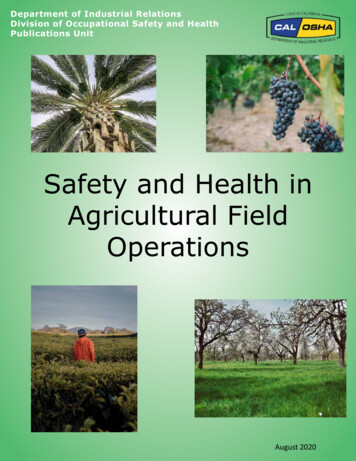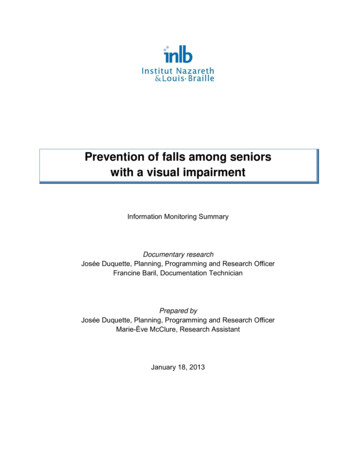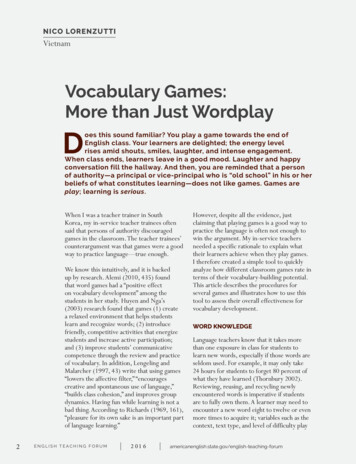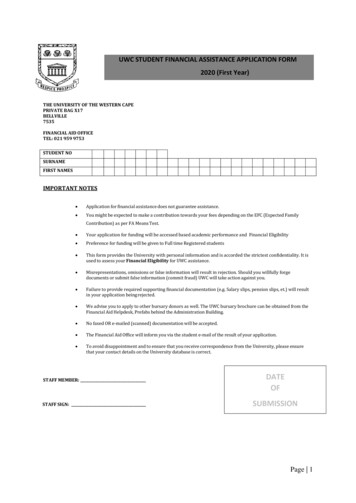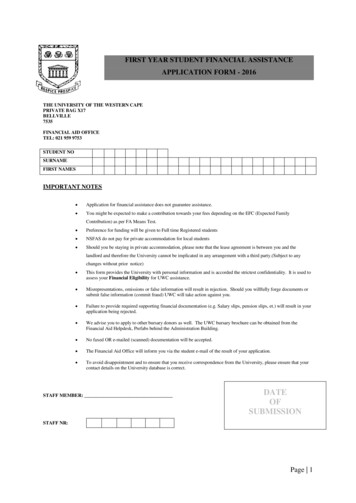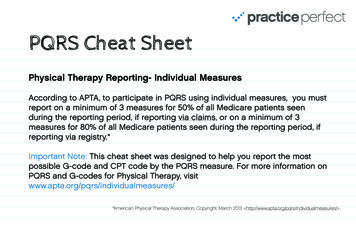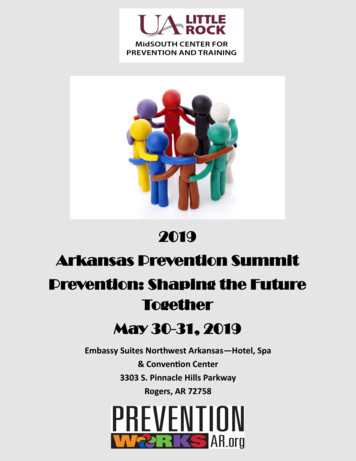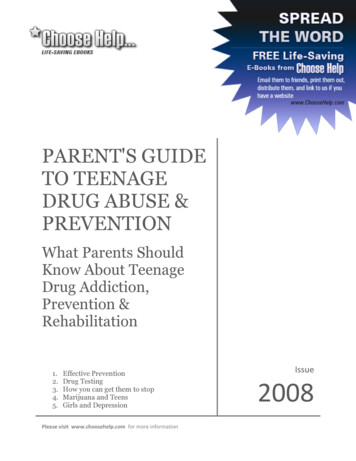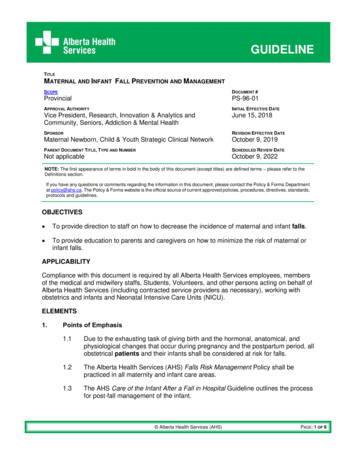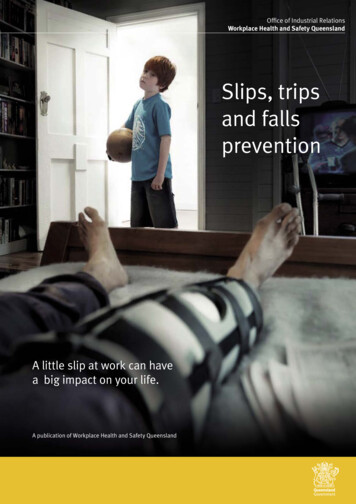
Transcription
Office of Industrial RelationsWorkplace Health and Safety QueenslandSlips, tripsand fallspreventionA little slip at work can havea big impact on your life.A publication of Workplace Health and Safety Queensland
“I was drilling on the factory floor. I tripped on the extension cord and did my back in. I’ll be out ofaction for weeks. Not just at work, but at home too.”
IntroductionEach year more than 13,000 Queensland workers suffer an injury as a result of a slip, trip orfall costing Queensland businesses more than 256,000 lost work days and over 60 million inworkers’ compensation payments.1In addition to workers’ compensation costs, there are financial, physical and emotional costs forthe injured worker and their family. A workplace injury often affects injured workers’ well beingby restricting their usual home and leisure activities.Simple and cost effective measures can reduce the number and severity of these injuries. Thisbooklet aims to provide you with a basic understanding of what causes a slip or trip and provideyou with some ideas on what you can do to stop these incidents occurring.Slips, trips and fallsSlips, trips and falls can happen in any workplace. They can occur at the entry of a building, inthe kitchen, in cold rooms, on loading docks and even as you walk outside the building.More serious slips or trips together with the resulting falls may result in: sprains or strains broken bones when trying to break the fall a back injury due to the sudden and forceful impact during a fall burns if it occurs near hot surfaces or if the person is handling hot fluids cuts if it occurs near sharp objects.Causes of slip, trips and fallsThere are various factors that contribute to the risk of slips and trips. Slips usually occur whenthere is a loss of grip between the shoe and the floor. This commonly occurs when there is acontaminant between the shoe and the floor. Trips occur when a person’s foot hits a low obstaclein the person’s path, causing a loss of balance. Often, the obstacle is not easily visible or noticed.The following factors can contribute to the risk of slips and trips. It is usually a combination ofthese factors that create the risk of a slip or trip.ContaminantsContaminants can be considered as anything that ends up on a floor. Contaminants can bewet such as water, oil or grease, or dry such as dust, metal shavings, plastic bags or off-cuts.Preventing floor contaminants is one of the best things you can do to prevent slips.Floor surfacesFloor surfaces require sufficient grip to prevent slipping, especially in areas which may becomewet or contaminated. The greater the thickness or viscosity of the contaminants, the greater theslip resistance of the flooring required to protect against slipping.1Associated payments include compensation payments ( 38.3M), goods and services payments ( 18.4M) and non-compensationpayments ( 4.3M). Source: Queensland Employee Injury Database as at August 2007, Workplace Health and Safety Queensland.Slips, trips and falls prevention1
CleaningCleaning affects every workplace and everyone in the workplace. Besides regular cleaningprograms, everyone has a role keeping the work area clear and taking responsibility for their ownspills.Floors need to be cleaned properly to ensure that: contaminants are effectively removed a build up of cleaning product residue is avoided the floor does not become too slippery floors maintain slip resistant properties (of non-slip flooring).Prompt attention to spills is also important in order to prevent slips.Obstacles and other trip hazardsTrips most often occur because of uneven flooring or cluttered walkways with low obstacles whichare not easily visible or noticed. Common examples of low obstacles include trailing cables, unevenedges to flooring, gratings or covers, loose mats or carpet tiles and changes of floor surface level.Trips can be prevented by: good housekeeping practices ensuring the floor surface is in good order such as being free from holes, uneven surfaces, curledup linoleum or carpet edges avoiding any changes in floor surface level, or if this is not possible, highlighting these changes providing adequate storage facilities.Environment, including lightingPoor lighting and distractions such as unfamiliar or unexpected loud noises, or extremeenvironmental conditions, such as extreme cold or heat, can impact a person noticing slip or triphazards in their path. Adequate light levels without glare or shadowing is required to highlightpotential slip or trip hazards. Other distractions, like those mentioned, should be minimised as muchas possible.People and activityWork activities, the way the work is organised and attitudes to safety can affect the worker’s abilityto see or think about where they are going. For example, people hurrying, carrying large objects,pushing high trolleys or talking on a mobile phone could contribute to the cause of a slip or trip.Workers need to be able to maintain their balance when performing tasks and be able to recover ifthey slip or trip. For example, when handling loads, workers should have full view of where theyneed to travel and should also have a free hand to hold onto a rail when walking down steps.Consideration should be given to: individuals physical attributes such as vision, balance and agility the work being carried out and how it is organised who will be walking through the area, including the public.2Workplace Health and Safety Queensland
FootwearFootwear plays an important role in reducing the risk of slips, trips and falls. Footwear should be: suitable for the type of work and work environment comfortable with an adequate non-slip sole and appropriate tread pattern checked regularly to ensure treads are not worn away or clogged with contaminants.Leads here, there and everywhere – Case StudyA worker carrying a box tripped and fell over an electrical lead that ran across the walkwayin a manufacturing workshop. During the fall he hit his head and shoulder on the corner of apiece of equipment. He sustained a serious shoulder injury which required major surgery. Thecompany was prosecuted and received a fine of 25,000. The injured worker was off work forthree months and could not be replaced for this period due to a skilled labour shortage.An inspection of the work area showed that: electrical leads for equipment used near the walkway often ran across the walkway lighting in the workshop was poor so he could not clearly see the electrical lead workers often carried bulky items along the walkway, which obstructed their view of thefloor.This incident could have been prevented by: positioning power outlets nearer to the point of use, to eliminate leads trailing across thewalkway providing adequate lighting in the workshop for safe movement and to highlightobstructions on the floor reducing the size of the load being carried or providingmechanical aids, such as trolleys so that bulky items can be moved around the workshopwithout obstructing the workers vision.Slips, trips and falls prevention3
Slippery kitchen floor – Case StudyTowards the end of a shift in a commercial kitchen, a worker slipped and fell sustaining seriousburns after coming in contact with a tub of hot water. The tub of water was used for cleaning thefloor at the end of the night. It was positioned beside the walkway near the deep fryer where inthe same area several floor tiles were missing. This hollowed area allowed pooling of water andoil which was tracked throughout the kitchen. The kitchen floor was properly cleaned once at theend of the night. Workers were advised to wear enclosed shoes, however no advice was providedregarding the type of non-slip sole that should be worn.The workplace was prosecuted and received a fine of 17,500. The injured worker was off workfor two months and the workplace had to recruit and train a new employee to fill in for thisperiod.This incident could have been prevented by: replacing the missing tiles to stop contaminants pooling on the floor installing splash guards on the deep fryer to prevent oil splashing onto the floor placing covers over the deep fryer when it was not in use to prevent workers coming intocontact with the hot oil putting in place spills management procedures so that spills are immediately attended to increasing the frequency of cleaning to minimise contaminants on the floor implementing a suitable footwear policy so that all workers wear shoes that have a non-slipsole.How to manage slips, trips and falls risksThe simplest way of preventing slips, trips and falls injuries in your workplace is to develop a riskmanagement plan which identifies, assesses, controls and monitors safety hazards and risks. Thefollowing information, together with the slips, trips and falls risk management tool and worksheetat the back of this booklet, will help you develop a risk management plan and record yourassessments.Identify hazardsIdentifying hazards is the first step to determine exactly where slips, trips and falls can orhave occurred in your workplace. You can find out this information by talking to workers andsupervisors, inspecting the premises, and reviewing records such as incident and injury reports aswell as workers’ compensation claims.Another useful method is to sketch a layout of the work area and mark on it where slip and tripincidents or hazards have been reported.Assess the riskThe next step is to assess the slip or trip risks. Usually it is a combination of factors that create therisk. Consider the risk assessment questions in the right hand column of the risk management toolto assist in determining the level of risk. The red and amber section of the risk management toolcan be helpful to determine the level of risk.4Workplace Health and Safety Queensland
As part of your assessment you should also consider: how many people are exposed the consequences of the slip or trip – a slip or trip with or without a fall can be more serious if itoccurs near hot, sharp or moving objects, or at a height, such as near stairs how often the situation occurs.Fix the problemLook at the assessed risks and decide what needs to be done to eliminate or reduce the risks andhow quickly these measures need to be implemented. There are six types of control strategies toeliminate or reduce the risks and they are listed below in order of their effectiveness.Hierarchy of controlsExamplesEliminate the hazardRemove slip and trip hazards at the design stage such as eliminatingchanges in floor levels; installing more power outlets through the floorand ceiling to avoid trailing cords.SubstitutionResurface floors.IsolationLimit access to high risk areas.Minimise risk by redesign(engineering means)Apply floor treatments to increase slip resistance; improve lighting; stopleaks from equipment or pipes; provide adequate drainage to preventpooling of contaminants; clearly mark edges of steps and any changes infloor height.Administrative controlsImplement good housekeeping practices such as clear access ways; promptspills management; use of signage or barricades for wet or slippery areas;training and supervision.Personal protectiveequipmentWear suitable footwear.Look at all the options available to you and select controls that will best reduce the risks.Commonly, a range of controls may be needed.If you are having trouble deciding what suitable controls are then read the green section of theslips, trips and falls risk management tool at the back of this booklet for some helpful ideas. Thenwrite down these controls on the risk management worksheet.If possible, trial the preferred control options before putting them into practice permanently.Develop work procedures to formalise the controls, communicate with workers the reason for thechange, and provide training and supervision for all staff.Monitor and review controlsIt is important to check whether the controls in place are effective, being used correctly, and havenot introduced new hazards or risks. This can be done by talking with your workers, observingwork activities, undertaking walk through surveys and reviewing incident and hazard reports.Slips, trips and falls prevention5
Other things to considerOther issues that you need to address in your risk management plan include design, maintenance,consultation, training and record keeping.DesignPrevention of slips, trips and falls starts with good design of the workplace. When fitting out newpremises/extensions or refurbishing the workplace, incorporate features to prevent slips and trips.This is detailed in the green section of the risk management tool.When commissioning or purchasing new equipment, as well as ensuring that it is safe, ensure itprovides adequate containment of any possible by-product such as off-cuts, grease, and dust.MaintenanceThis is fundamental to ensure that control measures remain effective. For slips and tripsprevention: maintain the condition of floor and ground surfaces, stairs and ramps maintain machinery to prevent leaks ensure there is adequate lighting ensure workers wear suitable footwear to provide adequate grip.ConsultationBefore changes are made to facilities and processes, or equipment is purchased, talk to workers inthe work area about the changes.TrainingAll staff should have good understanding of slips, trips and falls hazards and how they can playtheir part in preventing them. For example, train staff in the risks and control strategies thathave been implemented, including relevant procedures for cleaning and hazard reporting.Record keepingRecord all areas assessed and actions taken through the slips, trips and falls risk managementworksheet, specifications of plant and work processes, incident reports and actions undertaken,maintenance records of equipment and tools, and records of training activities.6Workplace Health and Safety Queensland
- Textured floors and slip-resistant surfaces areappropriate for the work performed.- Existing floors treated to improve slip resistance(e.g. acid etching, sandblasting, grinding andgrooving).- Flooring is level and unbroken.- Welded joins in flooring.- Minimum sudden changes in floor surface texture.- Changes in floor level highlighted with highvisibility edging.- Clear and level path.- Access ways that are slip resistant in the wet orsheltered from rain.- Ground surfaces and pathways maintained in goodcondition.- Grates or covers are in good condition with nonslip surfaces.- Short cuts across grassed or muddy areasdiscouraged.- Sudden changes in floorsurfaces (e.g. from tiles tocarpet).- Coating and tapes partiallyworn away.- Minor changes in level.- Isolated low step.- Minor changes in level.- Tree roots encroaching onpath.- Muddy areas.- Wet grass.- Uneven ground surfaces or pathways (e.g. unevenor loose paving; footpaths and garden edgingpoorly maintained; pot holes; cracked and unevenconcrete or bitumen; missing or damaged grates orcovers).- Surfaces that are slippery when wet (e.g. tiles,smooth concrete, grates or covers).- Slippery surfaces (e.g. metal grates or covers).External groundsurface andcondition, includingworkplace accessand egressLow – controlled riskLess likely to result in injury – possiblecontrolsModerate riskSome risk of injuryShort term controls- Slip resistance of flooring too low or patchyfor expected use, and type and amount ofcontaminants.- Aged flooring with reduced slip resistance.- Uneven floor surfaces (e.g. worn floor coverings,broken tiles, missing or damaged grates or covers).- Poorly maintained access ways (e.g. loose carpettiles).- Uneven floor heights (e.g. height differencebetween loading dock and floor of truck, gapbetween loading dock and truck).- Unmarked edges (e.g. end of loading dock).- Slippery metal surfaces (e.g. loading dock plates,walkways, grates or covers).High riskVery likely to cause injuryInternal floorsurface andconditionRisk factors- Are paths for accessand egress to theworkplace clear,slip resistant in badweather and withouttrip hazards?- Does the floor surfacehave enough slipresistance to protectagainst slippingwith expectedcontaminants?- Are tripping hazardseliminated?Risk assessmentquestionsYES/NO Write down the identified work area or activity on the following slips, trips and falls management worksheet. The following information is based on a traffic light approach with guidance on what is high risk (red), moderate risk (amber) and low or controlled risk(green). This can help assess the risks for specific situations. The guidance in green also provides ideas for controls. For a safe workplace you should answer YES to the risk assessment questions listed in the far right column. Identify the key risk factors involved.Commonly a number of risk factors are present. Write down the risks on the following worksheet. Further information can be sought from other publications such as Australian Standards and the Building Code of Australia.InstructionsSlips, Trips and Falls Risk Management Tool
Slips, trips and falls prevention8- Inadequately drained floor surfaces in wet areas(e.g. toilet/bathrooms, kitchens, food preparationarea).- Areas that may have fluid or other contaminants onthe floor (e.g. food preparation areas, particularlyaround sinks, deep fryers, urns; supermarketdelicatessens; wherever food and drinkconsumed).- Areas where leaks are common (e.g. oil stains inundercover concrete car-park).- Oil, water and other fluid leaks from machinery,work processes or stored containers.- Ice on cold room floors.- Dry contaminants (e.g. powders, granules, swarf )allowed to build up on floor.- Dry litter (e.g. cardboard, plastic wrapping) left onthe floor.- Wet surfaces near external doors where traffic andweather brings in rain water.- Moisture and fluids spills on external pathways.- Contaminants still present after cleaning.- Wet cleaning or polishing of floors during workinghours.- Build up of floor polish on the floor.- Detergent residue on the floor.- Untidy work areas (tools on floor, waste ormaterials accumulating on floor; storeroom withraw materials, rubbish, waste overflowing).- Accidental spills left unattended.- Storage of equipment and goods in aisles andwalkways.- Low obstacles where people need to walk (trailingextension cords; empty pallets; bolts or otheritems protruding from usekeeping/obstacles- Pedestrian walkwaysnot well defined (e.g.open areas used for workprocesses and pedestrianaccess).- Unsuitable matting such asflattened cardboard boxes.- Clear and unobstructed aisles and walkways withtrip hazards removed.- Highlight fixed obstacles (e.g. marked in brightyellow).- Adequate storage areas for goods, trolleys andequipment.- Power outlets positioned to avoid running cordsacross the floor.- Hazardous warning signs and procedure forimmediate spills management and clean up.- Provide enough waste bins and locate them closeto work area.- Isolated cleaning area from pedestrians (e.g.cleaning of floor surfaces outside working hours orexclude pedestrians from area till floors are dry).- Suitable cleaning to remove residue.- Staff trained in cleaning procedures.- Signage to remove or caution workers duringcleaning of floors.- Cleaning program in place to prevent build up ofcleaning product or residue.- Workers walking onrecently cleaned but wetfloor.- Debris, old leaves onpathways.- Adequate drainage with graduated floor todrainage points.- Deep profile tiles to drain fluids.- Ensure efficient drainage of outdoor groundsurfaces.- Good design of cold rooms, machinery andprocesses to eliminate or minimise leak or spreadof contaminants.- Slip-resistant and absorbent flooring or door matsat entrances should be secured or large enough toremain in place.- Cover at building entry to reduce rainwaterentering.- Umbrellas left at entrances in containers.- Proactive maintenance programs to detect andrepair signs of leaks.- Keep outdoor surfaces free of leaves, mud,clippings, paper and gravel and remove moss orslime with a chlorine-based solution.- Condensation on coldroom floors.- Machinery not regularlymaintained for leaks.- Growth over outsidepathways (e.g. moss andlichens).- Leaf litter.- Are the walkwaysthrough the workplaceand the floors nearwhere people workkept clear and tidy?- Are clean upprocedures effectivein promptly managingspills and keepingfloors and paths clearfrom waste material?- Is the cleaning practiceeffective in removingcontaminants and doesnot create a slip risk?- Can cleaning beundertaken with noor minimal pedestriantraffic in the area?- Is it dry beforepedestrians can walkon it?- Are water and othercontaminants wellcontained to minimiseits spread onto floorsor paths?
9Workplace Health and Safety Queensland- Inappropriately designed steps and stairs (egstairs with inadequate foot space; variable stepheights in staircase; steps with excessive radius onnosing).- Ramps that are too steep or with slippery surface.- Small or missing landings where doors opendirectly onto stairs.- Step edge and tread not obvious.- Heavy trolleys used on steep ramps.- Trolleys used on ramps without edge protection.- Rushing, running and performing manual tasks onfloors with contaminates.- Pressured work schedules creating speed andsudden changes in direction of movement.- Limited vision for pushing and carrying loads (e.g.tall trolley or large loads).- Unsuitable footwear worn for the task.- Shoes are not slip resistant.Stairs and rampsActivities (tasks)FootwearOther- Limited vision on stairs, at changes of floorsurfaces or floor levels, on ramps and walkways.- Glare on walkways.- Poorly lit work areas and walk ways.- Sudden changes in lighting levels between areas(e.g. between outdoors and a dimly lit stairwell,or between outdoors and loading bay; distractingshadows on steps, stairs and walking surfaces).Environment /lighting- Tread pattern worn.- Tread clogged withcontaminants (e.g. mud,dirt or grease).Good vision of path of travel.Use lifts where possible.Minimise carrying loads on stairs.Use suitable trolleys on stairs or provide ramps.Suitable footwear is worn.Work is organised so that the need to rush or run isavoided.- Suitable footwear policy in place (for selection andusage).- Wearing of suitable footwear is monitored.-- Are other potentialsources of slip, trip andfall risks managed?- Is footwear suited tothe purpose of thework?- Is footwearmaintained?- Can it provide goodgrip on the floor duringwork duties?- Do the work tasksallow the person toadequately maintaintheir balance andenable them to savethemselves from a slipor trip?- Do tasks allow workersto have an adequatevision of their path?- Are the stairs andramps appropriatelydesigned andmaintained in goodcondition?- Ramps and stairs designed to relevant standards.- Ramp surface made slip resistant with foot grips ortextured surface.- Sturdy handrails or guard rails on all platforms,steps or stairs.- Non-slip stair tread.- Clearly marked and non-slip step edges.- Adequate rails on ramp to prevent trolleys runningoff the edge.- Eliminate isolated low steps if practice.- Ensure isolated low steps are highlighted.- Non-slip treads.- Highlight the start and finish of ramps.- Covers to eliminate weather conditions.- No or inadequate handrails.- Poor condition of stepsand stairs.- Isolated low stepsparticularly at doorwaysand cold room entrances.- Speed humps thatencroach on pedestrianwalkways.- Only use steep stairwaysfor secondary access, andensure they have sturdyhandrails on both sides.- Carrying a load thatprevents workers fromgripping a handrail orbreaking a fall.- Handling unstable andunbalanced loads.- Is the lighting adequateto clearly see the pathof travel and slip andtrip hazards?- Are distractions in thearea minimised?- Adequate lighting for the work area and worktasks.- Clearly marked aisles.- Appropriate lighting and visual cues on hazardareas such as changes in floor surface level.- Adequate lighting for access ways including nighttime use.- Provide graduated lighting between areas.- Replace, repair or clean lights before levelsbecome too low for safe work.- Low level or obstructedlighting and shadowsaround hazards (e.g.objects in walkways,uneven flooring).- Increased risk whenworking in cold or heat(e.g. cold rooms orfreezers, humid conditionssuch as smoke house).
Slips, Trips and Falls Risk Management WorksheetProblem area or activityWork Area:Assessed by:Activity:Position/Job Title:Details:Date:Workers consulted:Identify the problems and assess the riskWhat are the risks? Refer to slips, trips and falls risk management tool for guidance on assessing risks (red andamber columns).Floors (internal or external)Cleaning proceduresStairs and rampFootwearContaminants and obstaclesActivityEnvironment/lightingOtherFind the solutionStep 1 - Decide on how to fix the problem* Refer to the slips, trips and falls risk management tool for guidance on controlling risks (green column).Can you eliminate the risks?Yes - How?NoCan you redesign theenvironment, activity, workprocess or equipment?For example:Apply floor treatments toincrease slip resistance.Improve lighting.Stop leaks from equipment orpipes.Provide adequate drainageto prevent pooling ofcontaminants.Clearly mark edges of steps andchanges in floor height.Yes - How?Can administrative controls also be used to minimise risks?NoFor example:Implement spillage management procedures.Implement suitable footwear policy.Carry out cleaning out of operational hours.Provide training on slips, trips and falls.How?Step 2 - Implement controls* Refer to the slips, trips and falls risk management tool for guidance on controlling risks (green column).Person responsible for putting the controls in place:By when:Review the controlsReviewed by://Date of review :/Have workers been consulted?Have the controls implemented, reduced the risk?Have any other risks been created by the controls?Can further controls be implemented to minimise the risk?/
“I was carrying a full tray down the stairs. I guess I should have used the lift, but it was really busyand I needed to save time. I slipped and injured my shoulder. It doesn’t hurt that much, but notplaying with Sally does.”
Further informationFor further general information on preventing slips, trips and falls,please contact Workplace Health and Safety Queensland:Telephone 1300 362 128Website: www.worksafe.gov.auTelephone interpreter service: 13 14 50The materials presented in this publication are distributed by the Office of IndustrialRelations as an information source only.The information and data in this publication are subject to change without notice.The Office of Industrial Relations makes no statements, representations, or warrantiesabout the accuracy or completeness of, and you should not rely on, any informationcontained in this publication. This document is a guide only and must be read inconjunction with the Workplace Health and Safety Act 2011.The Office of Industrial Relations disclaims all responsibility and all liability (includingwithout limitation liability in negligence) for all expenses, losses, damages and costsyou might incur as a result of the information being inaccurate or incomplete in anyway, and for any reason.AEU 16/5543 The State of Queensland (Office of Industrial Relations) 2016
at the back of this booklet, will help you develop a risk management plan and record your assessments. Identify hazards Identifying hazards is the first step to determine exactly where slips, trips and falls can or have occurred in your workplace. You can find out this information by talking to workers and
